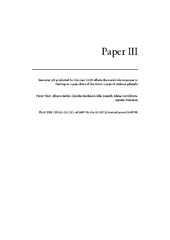Blar i forfatter "Bailey, Allison Michelle"
-
Contrasting physiological responses to future ocean acidification among Arctic copepod populations
Thor, Peter; Bailey, Allison Michelle; Dupont, Sam; Calosi, Piero; Søreide, Janne; De Wit, Pierre; Guscelli, Ella; Loubet-Sartrou, Lea; Deichmann, Ida M.; Candee, Martin M.; Svensen, Camilla; King, Andrew Luke; Bellerby, Richard (Journal article; Tidsskriftartikkel; Peer reviewed, 2017-08-17)Widespread ocean acidification (OA) is modifying the chemistry of the global ocean, and the Arctic is recognized as the region where the changes will progress at the fastest rate. Moreover, Arctic species show lower capacity for cellular homeostasis and acid‐base regulation rendering them particularly vulnerable to OA. In the present study, we found physiological differences in OA response across ... -
The fate of a key Arctic copepod in future ocean acidification: Integrating molecular, organismal, and evolutionary thinking in the face of climate change
Bailey, Allison Michelle (Doctoral thesis; Doktorgradsavhandling, 2017-05-05)Uptake of anthropogenic carbon dioxide (CO2) into the world’s oceans is increasing seawater acidity in a process termed ocean acidification. This is predicted to have harmful effects on a variety of marine organisms. With the greatest and fastest changes in pH expected to occur the Arctic seas over the next 100 years, the need for understanding the effects of low pH on Arctic marine organisms is ... -
Hydrography, inorganic nutrients and chlorophyll a linked to sea ice cover in the Atlantic Water inflow region north of Svalbard
Renner, Angelika; Bailey, Allison Michelle; Reigstad, Marit; Sundfjord, Arild; Chierici, Melissa; Jones, Elizabeth Marie (Journal article; Tidsskriftartikkel; Peer reviewed, 2023-11-04)Changes in the inflow of Atlantic Water (AW) and its properties to the Arctic Ocean bring more warm water, contribute to sea ice decline, promote borealisation of marine ecosystems, and affect biological and particularly primary productivity in the Eurasian Arctic Ocean. One of the two branches of AW inflow follows the shelf break north of Svalbard, where it dominates oceanographic conditions, ... -
Regulation of gene expression is associated with tolerance of the Arctic copepod Calanus glacialis to CO2-acidified sea water
Bailey, Allison Michelle; De Wit, Pierre; Thor, Peter; Browman, Howard; Bjelland, Reidun Marie; Shema, Steven; Fields, David M.; Runge, Jeffrey A.; Thompson, Cameron; Hop, Haakon (Journal article; Tidsskriftartikkel; Peer reviewed, 2017-08-02)Ocean acidification is the increase in seawater pCO2 due to the uptake of atmospheric anthropogenic CO2, with the largest changes predicted to occur in the Arctic seas. For some marine organisms, this change in pCO2, and associated decrease in pH, represents a climate change-related stressor. In this study, we investigated the gene expression patterns of nauplii of the Arctic copepod Calanus glacialis ... -
Seasonal plankton dynamics in Kongsfjorden during two years of contrasting environmental conditions
Assmy, Philipp; Kvernvik, Ane Cecilie; Hop, Haakon; Hoppe, Clara J.M.; Chierici, Melissa; David T., Divya; Duarte, Pedro; Fransson, Agneta; García, Laura M.; Patuła, Weronika; Kwaśniewski, Sławomir; Maturilli, Marion; Pavlova, Olga; Tatarek, Agnieszka; Wiktor, Jozef M; Wold, Anette; Wolf, Klara K.E.; Bailey, Allison Michelle (Journal article; Tidsskriftartikkel; Peer reviewed, 2023-02-24)Seasonal plankton time-series data are presented from Kongsfjorden from two years with contrasting environmental conditions. Kongsfjorden (west coast of Spitsbergen – 79°N) integrates inputs from Atlantic and Arctic waters, and glacier run-off, and is thus a prime location to study impacts on ecosystem dynamics of key environmental drivers that are relevant across the Arctic. Despite extensive ...


 English
English norsk
norsk



